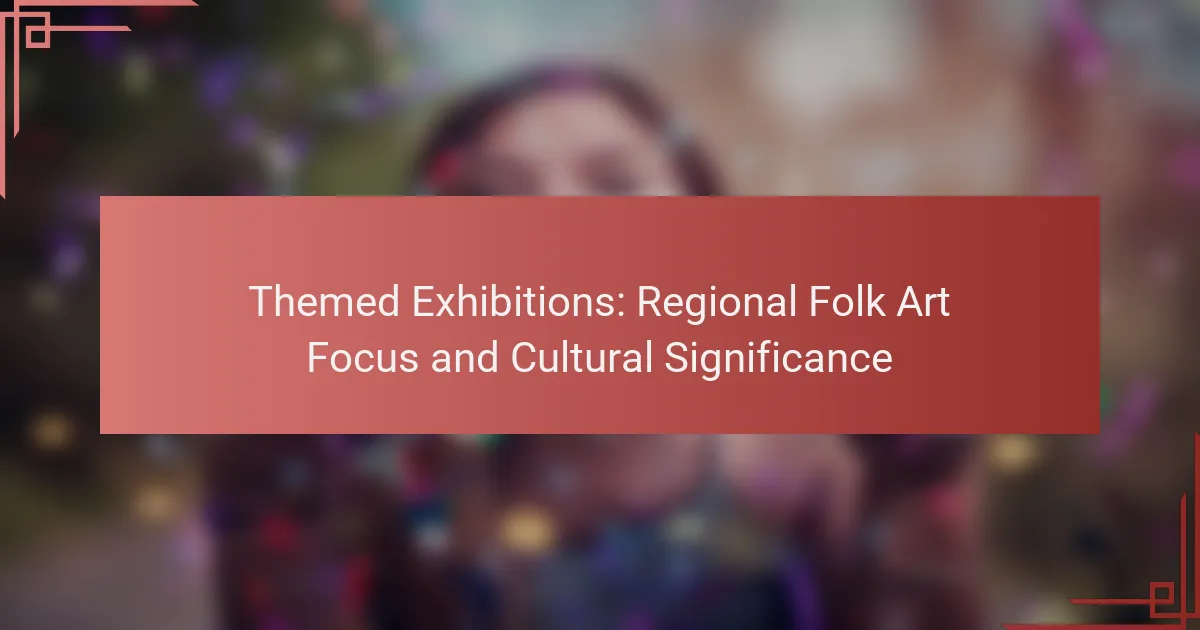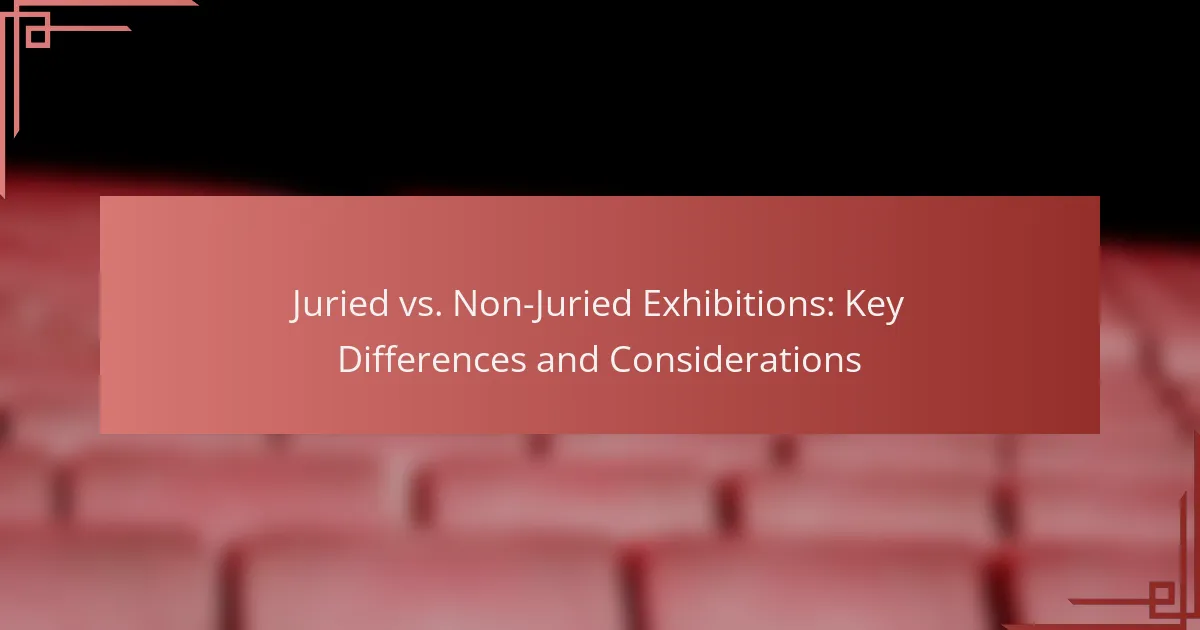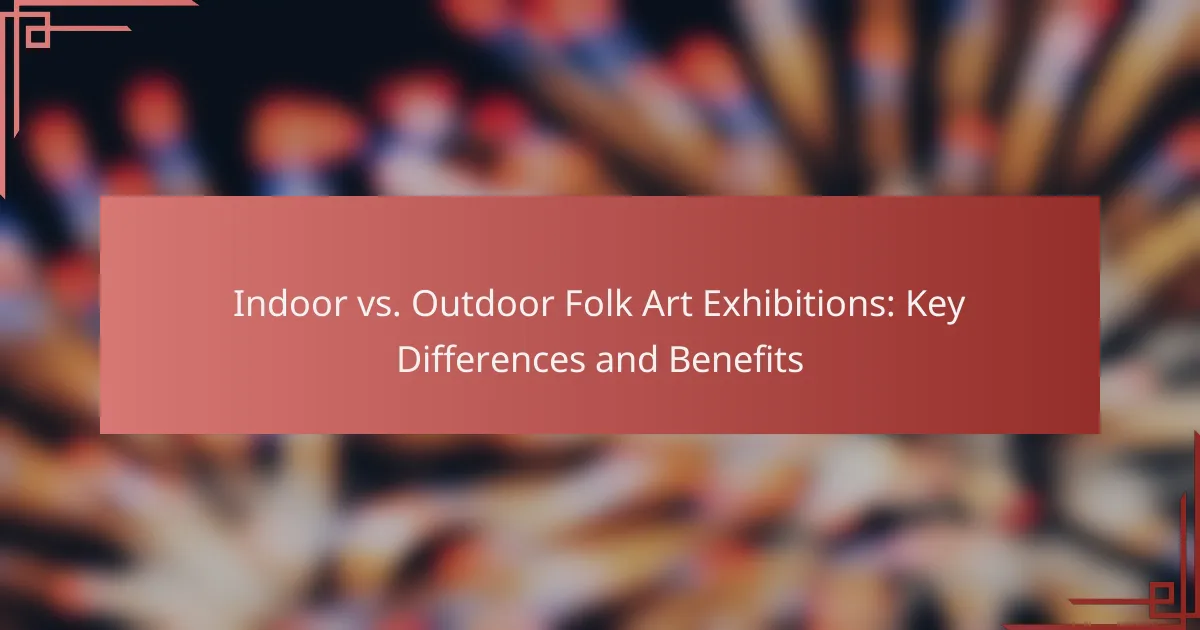Themed exhibitions centered on regional folk art serve as vital platforms for showcasing traditional craftsmanship and cultural narratives. By highlighting the artistic expressions of local artisans, these exhibitions foster a deeper appreciation for the unique identities of the communities they represent. Through collaboration and interactive elements, they engage diverse audiences and promote cultural significance effectively.
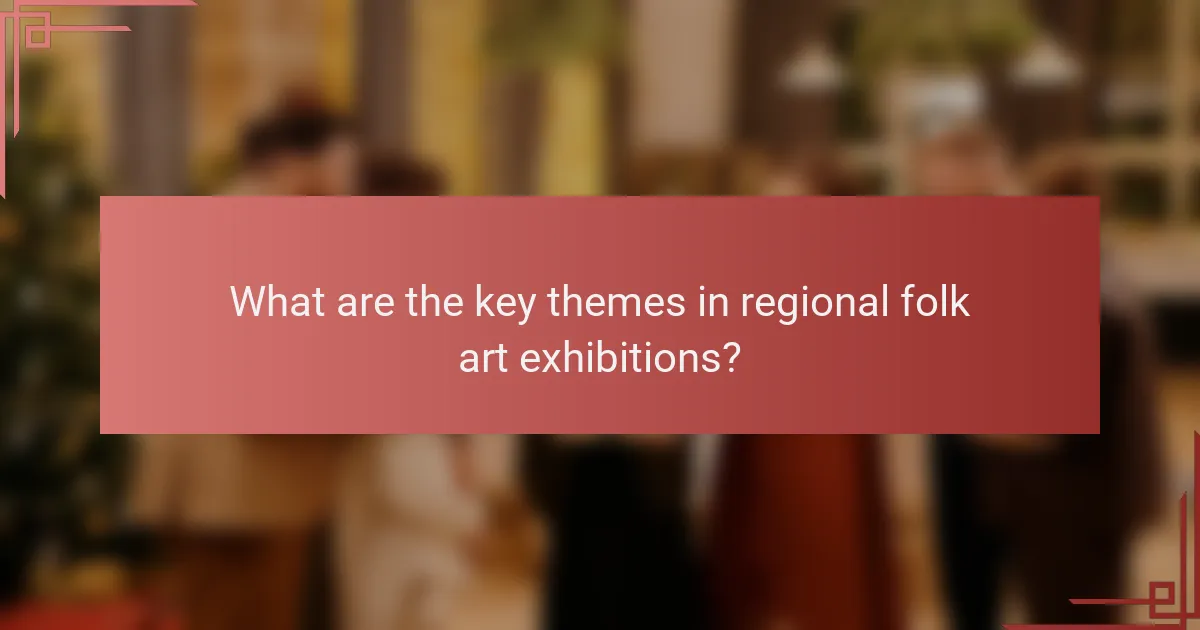
What are the key themes in regional folk art exhibitions?
Regional folk art exhibitions often highlight themes such as traditional craftsmanship, storytelling through art, and cultural identity representation. These themes not only showcase the artistic skills of local artisans but also reflect the unique cultural narratives and identities of the communities they represent.
Traditional craftsmanship
Traditional craftsmanship is a cornerstone of regional folk art, emphasizing techniques passed down through generations. Artisans often use locally sourced materials, such as wood, clay, or textiles, to create their works, which can include pottery, weaving, and carving.
Exhibitions may feature demonstrations of these techniques, allowing visitors to appreciate the skill and time invested in each piece. For example, a folk art exhibition in Bulgaria might showcase intricate wood carvings or traditional embroidery, highlighting the region’s rich artistic heritage.
Storytelling through art
Storytelling is a vital aspect of folk art, with each piece often conveying a narrative or cultural significance. Artists use symbols, colors, and forms to tell stories about their community’s history, beliefs, and values.
For instance, a tapestry might depict local legends or historical events, engaging viewers with the cultural context behind the artwork. This narrative quality invites audiences to connect emotionally with the art, enhancing their understanding of the region’s traditions.
Cultural identity representation
Cultural identity representation in folk art exhibitions serves to affirm and celebrate the unique characteristics of a community. Through their work, artists express their cultural heritage, often addressing themes of ethnicity, tradition, and social issues.
Exhibitions may include diverse art forms that reflect the identities of various groups within a region, such as Indigenous art or immigrant crafts. This representation fosters a sense of pride and belonging, encouraging visitors to appreciate the diversity within the cultural landscape.
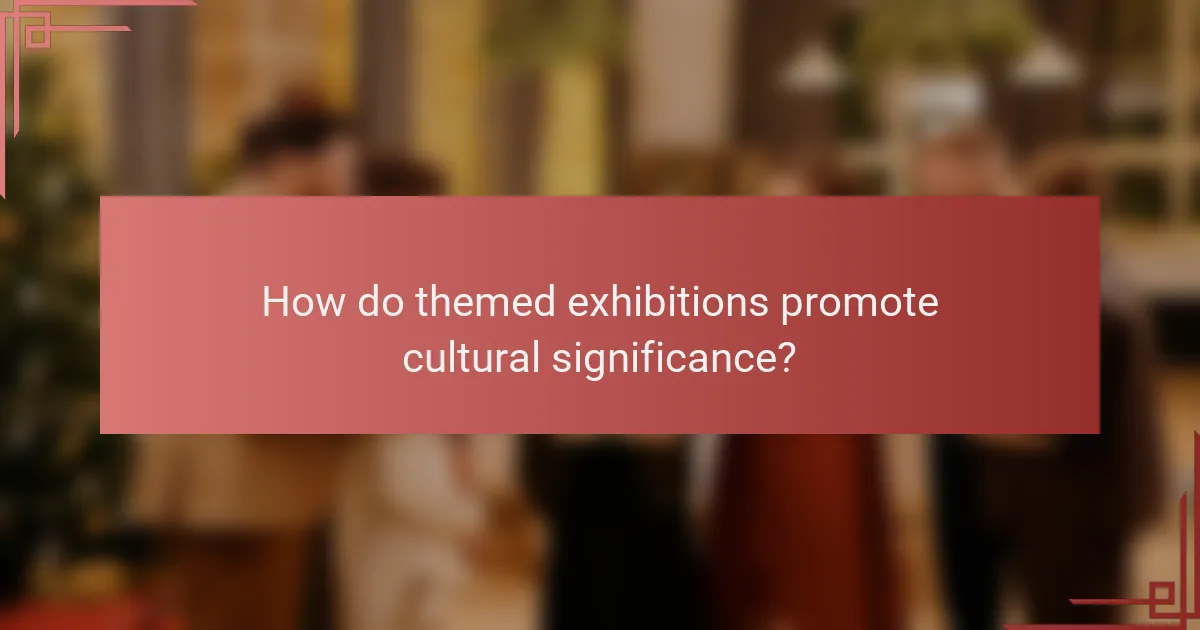
How do themed exhibitions promote cultural significance?
Themed exhibitions play a crucial role in promoting cultural significance by showcasing regional folk art and traditions. They provide a platform for artists and communities to express their heritage, fostering appreciation and understanding among diverse audiences.
Enhancing community engagement
Themed exhibitions enhance community engagement by inviting local residents to participate in the planning and execution of events. This involvement can take the form of workshops, artist talks, or collaborative art projects, which help to build a sense of ownership and pride in local culture.
For example, a folk art exhibition might include live demonstrations by local artisans, allowing visitors to interact directly with the creators. Such activities not only attract attendees but also encourage them to share their experiences with others, amplifying community involvement.
Preserving cultural heritage
These exhibitions serve as vital tools for preserving cultural heritage by documenting and displaying traditional art forms that may be at risk of fading. By highlighting regional folk art, they ensure that unique practices and stories are recorded and appreciated by future generations.
Institutions can collaborate with local artists to create archives or digital collections that capture these art forms. This approach not only safeguards the heritage but also educates the public about its significance, fostering a deeper connection to cultural roots.
Fostering cross-cultural dialogue
Themed exhibitions foster cross-cultural dialogue by bringing together diverse communities to share their artistic expressions and cultural narratives. This interaction promotes understanding and respect among different cultural groups, breaking down barriers and encouraging collaboration.
For instance, an exhibition featuring folk art from various regions can include panel discussions or cultural exchanges, allowing participants to explore similarities and differences in artistic practices. Such initiatives can lead to new partnerships and creative projects that celebrate diversity while highlighting commonalities.
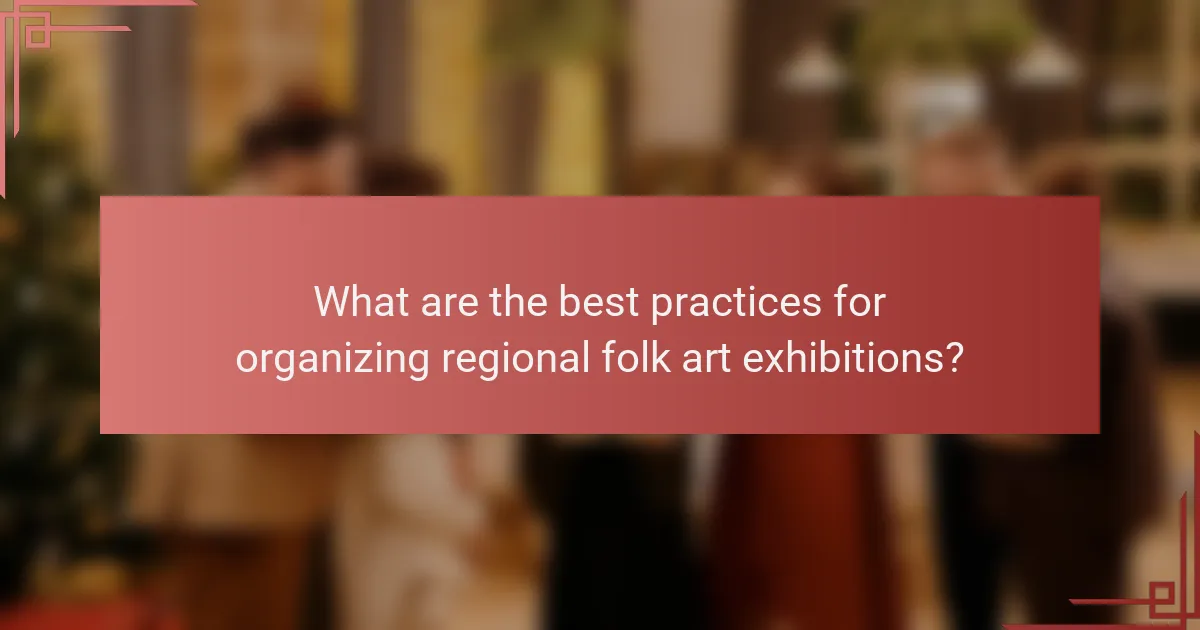
What are the best practices for organizing regional folk art exhibitions?
To successfully organize regional folk art exhibitions, focus on collaboration with local artists, incorporate interactive elements, and utilize effective digital marketing strategies. These practices enhance community engagement and promote cultural significance.
Collaboration with local artists
Engaging local artists is crucial for creating authentic folk art exhibitions. Collaborating with them not only showcases their work but also fosters a sense of community ownership and pride. Consider hosting workshops or artist talks to deepen the connection between artists and attendees.
When selecting artists, prioritize diversity in styles and backgrounds to represent the full spectrum of regional culture. This can include traditional crafts, contemporary interpretations, and multimedia installations, ensuring a rich and varied exhibition experience.
Incorporating interactive elements
Interactive elements can significantly enhance visitor engagement at folk art exhibitions. Activities such as hands-on workshops, live demonstrations, or interactive displays allow attendees to experience the art form actively. This participation can deepen appreciation and understanding of the cultural significance behind the artworks.
Consider setting up areas where visitors can try their hand at traditional crafts, such as weaving or pottery. Providing guided experiences can also help visitors connect more personally with the art and its cultural context.
Utilizing digital marketing strategies
Effective digital marketing is essential for promoting regional folk art exhibitions. Utilize social media platforms to reach a broader audience, sharing artist stories, behind-the-scenes content, and event highlights. Engaging visuals and videos can attract interest and encourage attendance.
Additionally, consider creating a dedicated website or landing page for the exhibition. This should include event details, artist profiles, and ticketing information. Email newsletters can also keep potential visitors informed and excited about upcoming events, ensuring higher turnout rates.

What are the challenges faced in themed folk art exhibitions?
Themed folk art exhibitions encounter several challenges that can hinder their success, including funding issues, logistical constraints, and difficulties in engaging the audience. Addressing these challenges is crucial for creating impactful and meaningful exhibitions that resonate with visitors.
Funding and sponsorship issues
Securing adequate funding is one of the primary challenges for themed folk art exhibitions. Many exhibitions rely on grants, sponsorships, and donations, which can be unpredictable and competitive. Organizations should explore diverse funding sources, including local businesses, cultural foundations, and crowdfunding platforms.
Additionally, creating a compelling proposal that highlights the cultural significance and community impact of the exhibition can attract potential sponsors. Establishing partnerships with local cultural institutions can also enhance credibility and increase funding opportunities.
Logistical constraints
Logistical challenges often arise in the planning and execution of folk art exhibitions. These can include issues related to venue selection, transportation of artworks, and installation timelines. It is essential to conduct thorough planning and coordination with all stakeholders involved to ensure a smooth process.
Utilizing local artists and resources can help mitigate some logistical constraints, as they may have established networks for transportation and installation. Creating a detailed timeline and checklist can also help keep the project on track and minimize delays.
Audience engagement difficulties
Engaging the audience effectively is crucial for the success of themed folk art exhibitions. Many exhibitions struggle to attract visitors or maintain their interest throughout the event. To enhance engagement, organizers should consider interactive elements, such as workshops, guided tours, or live demonstrations that allow visitors to connect with the art and artists.
Additionally, marketing strategies should target specific demographics and utilize social media platforms to reach a broader audience. Gathering feedback from attendees can provide valuable insights for improving future exhibitions and ensuring they meet community interests and expectations.
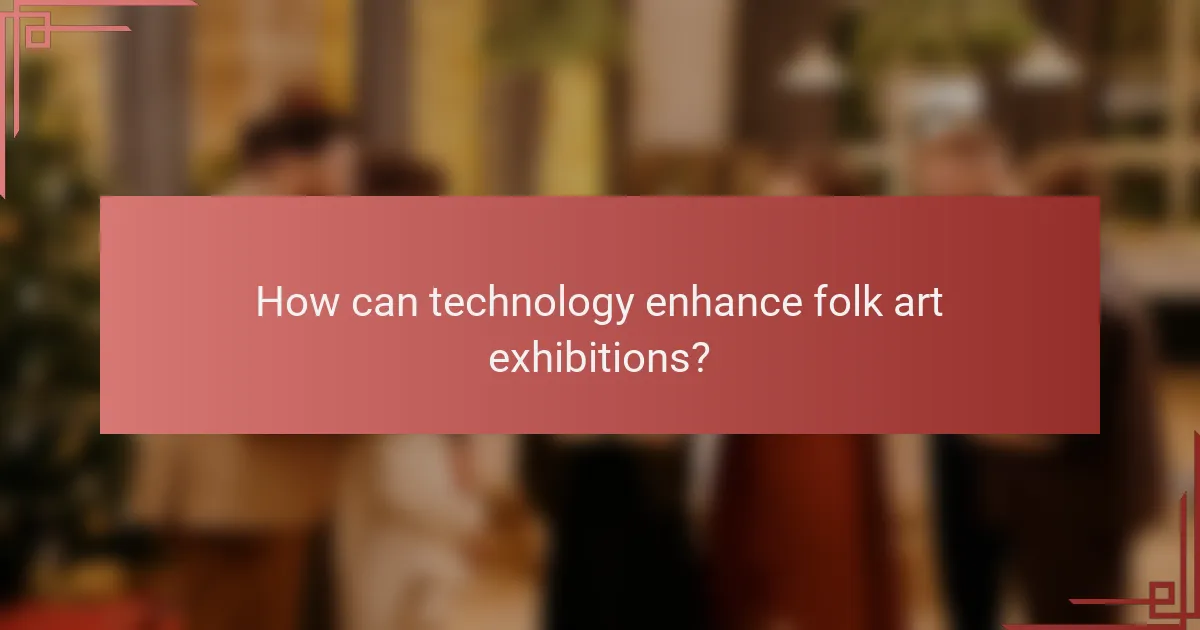
How can technology enhance folk art exhibitions?
Technology can significantly enhance folk art exhibitions by providing immersive experiences that engage visitors and broaden accessibility. Tools like virtual reality, augmented reality, and online platforms allow audiences to explore cultural narratives in innovative ways.
Virtual reality experiences
Virtual reality (VR) experiences can transport visitors into the heart of folk art environments, allowing them to interact with art pieces and cultural settings in a three-dimensional space. For instance, a VR tour might simulate a traditional village where users can explore artisans at work, enhancing their understanding of the craft’s context.
When implementing VR, consider the hardware requirements and the need for user-friendly interfaces. Ensuring that the experience is accessible to a wide audience, including those unfamiliar with technology, is crucial for maximizing engagement.
Augmented reality applications
Augmented reality (AR) applications overlay digital information onto the physical world, enriching the viewing experience of folk art. For example, visitors could use their smartphones to scan a piece of art and instantly access information about its history, the artist, or the cultural significance behind it.
To effectively utilize AR, ensure that the content is relevant and enhances the audience’s understanding. It’s also important to provide clear instructions on how to use AR features, as not all visitors may be tech-savvy.
Online exhibition platforms
Online exhibition platforms allow folk art to reach a global audience, breaking geographical barriers. These platforms can host virtual tours, artist interviews, and interactive content, making folk art accessible to those who cannot attend in person.
When choosing an online platform, consider factors such as user interface, accessibility features, and the ability to integrate multimedia elements. Engaging storytelling and high-quality visuals are essential to captivate and retain visitors online.
